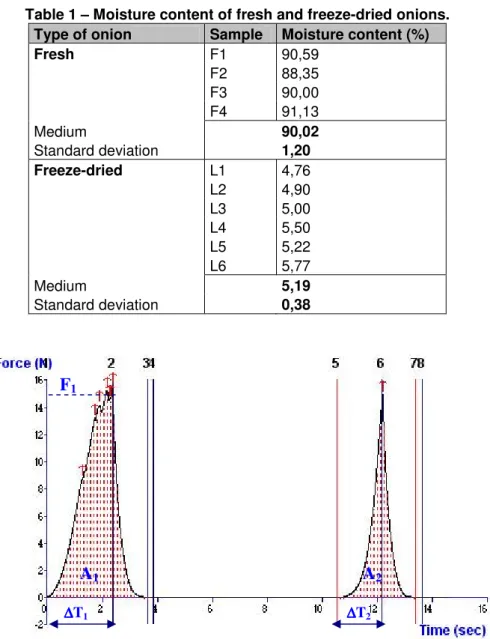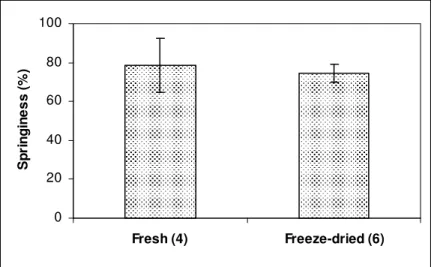Texture of onions before and after freeze-drying
Raquel P. F. Guiné
1*and Maria João Barroca
21
CI&DETS - ESAV, Polytechnic Institute of Viseu,Quinta da Alagoa, Estrada de
Nelas, Ranhados, 3500-606 Viseu, Portugal.
2
CERNAS-ESAC, Polytechnic Institute of Coimbra, Bencanta,
3040-316 Coimbra, Portugal.
Abstract: In the present work the textural properties of onion, fresh and after freeze-drying, were
studied, to understand how this drying treatment influences the texture of this food product. The fresh product had an average moisture content of 90.02 % and the freeze-dried onion had a moisture content of 5.19 %.
From the TPA to the fresh samples and to the freeze-dried samples it was possible to conclude that the hardness of the onions decreased very much from the fresh to the dried state. A similar behaviour was observed for the chewiness, which also decreased, but in a much less extent. On the other hand, cohesiveness increased slightly with drying. In relation to springiness, this property was not affected from drying, being the value in the fresh state quite similar to the value in the freeze-dried state.
Keywords: Onion, dried onion, texture, TPA.
Introduction
Onion, Allium cepa, L., is considered one of the most important crops around the world. Onion is a strong-flavored vegetable used in very different ways, and its high contents in organo-sulphur compounds is the main responsible for its characteristic flavor (pungency) or aroma, biological components and medical functions (1).
Bulbs from onion species are widely used in food flavoring, and have been very much appreciated over the years, both because of its characteristic taste and smell and also because they contain significant amounts of some beneficial compounds such as allicin and their derivatives or flavonoid glycosides (2,3). Moreover, Allium species are rich in flavonols, among which quercetin, known for its antioxidant and free radical scavenging power and its capability to protect against cardiovascular disease (4). For all these reasons, onion can be considered a good antioxidant additive for food (5,6).
Dehydrated onion is widely used as flavor additive in the manufacture of processed foods such as soups, sauces, salad dressings, sausage and meat products, packet food and many other convenience foods. In fact, the dehydrated form is preferred to the fresh product, because it has better storage properties and is easier to use (7, 8). In addition, the preservation of onion in the dried form is commonly practiced to reduce the bulk handling, to facilitate transportation and to allow the use during the off-season. However, when drying shelf-stable vegetables it is absolutely essential to preserve their desired quality attributes.
In the present work fresh and freeze-dried onions were analysed in terms of Texture Profile Analysis (TPA) to evaluate in what extent this operation influences the textural properties of onions.
Materials and Methods
Fresh onions of the Portuguese variety Mondego from a local market were selected and washed. The samples were frozen in a conventional kitchen freezer, and then left in the freeze-drier (model Table Top TFD5505, from Uniequip, Germany) for 38 hours at a temperature between - 47 ºC and - 50ºC, and a pressure of 5 mTorr (0,666 Pa).
Samples of the fresh and freeze-dried onion were used to calculate the average moisture content, which was measured with a Halogen Moisture Analyser (model HG53, from Mettler Toledo, USA), set to a temperature of 125 ºC and a speed 3 (in the range 1 to 5, being 1 fast and 5 slow).
*
The texture profile analysis to all the samples was performed using a Texture Analyser (model TA.XT.Plus, from Stable Micro Systems, UK), and the textural properties: hardness, springiness, cohesiveness, and chewiness were then calculated after equations (1) to (4) (see Figure 1):
Hardness = F1 [1]
Springiness = ∆T2/∆T1 [2]
Cohesiveness = A2/A1 [3]
Chewiness = Hardness * Cohesiveness * Springiness [4]
Results and Discussion
Table 1 shows the results of the moisture analysis to the onions in fresh and after freeze-drying. The fresh onion had 90.02 (± 1.20) % moisture (wet basis) and the freeze-drying operation reduced the moisture content to 5.19 (± 0.38) % (w.b.).
Figures 1 and 2 show the TPA obtained for the fresh and freeze-dried onion, respectively. It is visible that the hardness of the fresh onion is very much higher than that of the freeze-dried, about 15 N in the fresh against about 3 N in the dried sample. This difference can also be observed in Figure 3, where the average value for the hardness was calculated for all the samples analysed: 4 samples for the fresh product and 6 samples for the freeze-dried onion. The average hardness of the fresh onion was found to be 12.87 (± 2.24) N and that for the freeze-dried was 3.50 (± 0.71) N.
Table 1 – Moisture content of fresh and freeze-dried onions. Type of onion Sample Moisture content (%)
Fresh F1 90,59 F2 88,35 F3 90,00 F4 91,13 Medium 90,02 Standard deviation 1,20 Freeze-dried L1 4,76 L2 4,90 L3 5,00 L4 5,50 L5 5,22 L6 5,77 Medium 5,19 Standard deviation 0,38
Figure 1 – Texture Profile Analysis (TPA) of fresh onion. ∆ ∆ ∆ ∆T1 ∆∆∆∆T2
A
1A
2F
1
Figure 4 shows the average values of the cohesiveness, and it is observed that this property increases slightly with drying, from an average of 0,41 (± 0,03) in the fresh form to 0,65 (± 0,07) in the freeze-dried product. 0 2 4 6 8 10 12 14 16 Fresh (4) Freeze-dried (6) H a rd n e s s ( N )
Figure 3 – Hardness of fresh and freeze-dried onion (in parenthesis the number of samples).
0,0 0,2 0,4 0,6 0,8 Fresh (4) Freeze-dried (6) C o h e s iv e n e s s
In Figure 5 the values found for the average springiness are shown for the fresh onion, 78.72 (± 13.78) %, and for the dried onion, 74.64 (± 4.51) %, in this case the values are very similar, indicating that this drying treatment did not affect the springiness of onion.
Figure 6 shows the chewiness of the fresh and dried onions. In the fresh state, the onions show an average chewiness of 4.03 (± 0.49) N and after the freeze-drying treatment the chewiness diminished to 1.68 (± 0.32) N.
Conclusions
From the TPA to the fresh samples and to the freeze-dried samples it was possible to observe that the freeze-drying treatment substantially influenced the hardness of the onions, decreasing from the fresh to the dried state. The chewiness is another textural property that decreased with drying, although not so strongly as hardness. On the contrary, cohesiveness increases slightly with drying. As to the springiness, its value was not affected with drying, and the value in the fresh state is approximately the same as in the freeze-dried state.
0,0 1,0 2,0 3,0 4,0 5,0 Fresh (4) Freeze-dried (6) C h e w in e s s ( N )
Figure 6 – Chewiness of fresh and freeze-dried onions (in parenthesis the number of samples).
0 20 40 60 80 100 Fresh (4) Freeze-dried (6) S p ri n g in e s s ( % )
Figure 5 – Springiness of fresh and freeze-dried onions (in parenthesis the number of samples).
References
1. M. Corzo-Martínez; N. Corzo and M. Villamiel, Trends in Food Science & Technology, 18 (2007) 609-625.
2. A. Crozier, A; M. E. J. Lean; S. M. McDonald and C. Black, Journal of Agriculture and Food
Chemistry, 45 (1997) 590-595.
3. H. Xiao and K. L. Parkin, Journal of Agriculture and Food Chemistry, 50 (2002) 2488-2493.
4. P. M. Clifton, Journal of Biomedicine and Biotechnology, 5 (2004) 272-278.
5. E. Ostrowska; N. K. Gabler; S. J. Sterling; B. G. Tatham; R. B. Jones; and D. R. Eagling, British
Journal of Nutrition, 91 (2004) 211-218.
6. D. Boskou, Trends in Food Science & Technology, 17 (2006) 505-512. 7. R. S. Rapusas and R. H. Driscoll, Drying Technology, 13 (1995) 1905-1931. 8. F. Kaymak-Ertekin and A. Gedik, Journal of Food Engineering, 68 (2005) 443-453.


